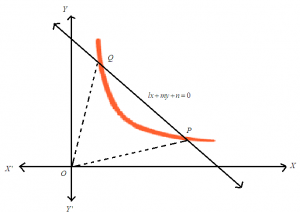Are you already tensed by knowing that you are hardly left with two more months of preparation..? Now, it’s the time for you to give up your old practice methods and to make a perfect move..!!
Whenever you start any topic and learn it, make sure you note all the important formulae and shortcuts to make your revision more effective.
Here are few such tips on the topic Pair of Straight Lines.
1. Joint equation of the straight lines a₁x + b₁y + c₁ = 0, a₂x + b₂y + c₂ = 0 is (a₁x + b₁y + c₁) (a₂x + b₂y + c₂) = 0.
2. If a, b, h are real then H = ax² + 2hxy + by² = 0 is called a homogenous equation of degree 2
3. If a, b, h are not all 0 then the equation H = ax² + 2hxy + by² = 0 represents straight lines if h² ≥ ab.
4. If h² ≥ ab, lines are coincident.
5. If h² ≥ ab then we can write H ≡ (l₁x + m₁y) (l₂x + m₂y) so that l₁l₂ = a, m₁m₂ = b, l₂m₁ + m₂l₁ = 2h.
6. If H = 0 represents a pair of straight lines and b is not equal to zero, if m₁, m₂ are slopes of lines. Then ax² + 2hxy + by² = b (y – m₁x) (y – m₂x), \({{m}_{1}}+{{m}_{2}}=\frac{-2h}{b}\), \({{m}_{1}}{{m}_{2}}=\frac{a}{b}\).
7. The equation to the pair of lines passing through origin and perpendicular to pair of lines is ax² + 2hxy + by² = 0is bx² – 2hxy + ay² = 0.
The product of perpendicular let fall from the point (x₁, y₁) upon the lines is ax² + 2hxy + by² = 0 is \({{P}_{1}}{{P}_{2}}=\frac{ax_{1}^{2}+2h{{x}_{1}}{{y}_{1}}+by_{1}^{2}}{\sqrt{{{\left( a-b \right)}^{2}}+4{{h}^{2}}}}\).
Angle between pair of lines ax² + 2hxy + by² = 0 is \(\tan \theta =\frac{2\sqrt{{{h}^{2}}-ab}}{a+b}\) and \(\cos \theta =\frac{|a+b|}{\sqrt{{{\left( a-b \right)}^{2}}+4{{h}^{2}}}}\).
If the lines are coincident then tanθ = 0
h² = ab
If the lines are perpendicular then cosθ = 0
|a + b| = 0
a = – b
Bisectors of the Angle between the lines by a Homogenous equation: The joint equation of the bisectors of the angles between the lines represented by the equation ax² + 2hxy + by² = 0 is \(\frac{{{x}^{2}}-{{y}^{2}}}{a-b}=\frac{xy}{h}\).
The necessary and sufficient condition for ax² + 2hxy + by² + 2gx + 2fy + c = 0 to represent a pair of straight lines is that \(\left| \begin{matrix}a & h & g \\h & b & f \\g & f & c \\\end{matrix} \right|=0\) and h² ≥ ab, g² ≥ ac, f² ≥ bc.
Equations of bisectors: The equations of the bisectors of the angles between the lines represented by ax² + 2hxy + by² + 2gx + 2fy + c = 0 are given by \(\frac{{{\left( x-{{x}_{1}} \right)}^{2}}-{{\left( y-{{y}_{1}} \right)}^{2}}}{a-b}=\frac{\left( x-{{x}_{1}} \right)-\left( y-{{y}_{1}} \right)}{h}\).
Where (x₁, y₁) is the point of intersection of lines represented by given equations.
If ax² + 2hxy + by² + 2gx + 2fy + c = 0 represents a pair of parallel straight lines then h² = ab, af² = bg², \(\frac{a}{h}=\frac{h}{b}=\frac{g}{f}\) and distance between those parallel lines is \(2\sqrt{\frac{{{g}^{2}}-ac}{a\left( a+b \right)}}=2\sqrt{\frac{{{f}^{2}}-bc}{b\left( a+b \right)}}\).
If the equation ax² + 2hxy + by² + 2gx + 2fy + c = 0 represent pair of straight lines then they intersect at point \(\left( \frac{hf-bg}{ab-{{h}^{2}}},\,\frac{hg-af}{ab-{{h}^{2}}} \right)\).
If the equation ax² + 2hxy + by² + 2gx + 2fy + c = 0 represents two straight lines then the product of perpendicular drawn from origin to these lines is \(\frac{c}{\sqrt{{{\left( a-b \right)}^{2}}+4{{h}^{2}}}}\).
Area formed by lines represented ax² + 2hxy + by² + 2gx + 2fy + c = 0 and axis of x is \(\Delta =\frac{{{g}^{2}}-ac}{\sqrt{ab-{{h}^{2}}}}\).
Lines joining origin to the point of intersection of curve: The combined equation of the straight lines joining the origin to the points of intersection of a second degree curve ax² + 2hxy + by² + 2gx + 2fy + c = 0 and a straight line is lx + my + n = 0 is \(ax{}^\text{2}\text{ }+\text{ }2hxy\text{ }+\text{ }by{}^\text{2}\text{ }+\text{ }2g\left( \frac{lx+my}{n} \right)x\text{ – }2f\left( \frac{lx+my}{n} \right)y\text{ }+\text{ }c{{\left( \frac{lx+my}{n} \right)}^{2}}\text{ }=\text{ }0\). Area of triangle formed by ax² + 2hxy + by² = 0 and is lx + my + n = 0 is \(\Delta =\left| \frac{{{n}^{2}}\sqrt{{{h}^{2}}-ab}}{a{{m}^{2}}-2hlm+b{{m}^{2}}} \right|\).
Area of triangle formed by ax² + 2hxy + by² = 0 and is lx + my + n = 0 is \(\Delta =\left| \frac{{{n}^{2}}\sqrt{{{h}^{2}}-ab}}{a{{m}^{2}}-2hlm+b{{m}^{2}}} \right|\).
